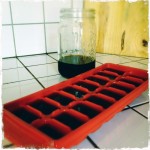Ahh, Aphids! And Other Garden Pests…
I was watering my hanging baskets when I noticed hundreds of aphids on the underside of the delicate petunia petals. I almost fell off the ladder! Unmanaged infestations will kill plants within a few weeks. Aphids are very small bugs – bright green, burnt orange, or black in color. If you see them, take action quickly.

Here you can see aphids on the flower and one ladybug larva enjoying a feast.
To combat these garden pests, fill a water bottle and add natural dish soap (1-2 tablespoons). Shake, then spray the plants once a day until the aphids are gone. This is a simple, inexpensive home remedy.
Ladybugs love to eat aphids, thrips, and other similar garden pests. Immediately after hatching, the larvae begin to feast, consuming about 350 to 400 aphids in two weeks’ time. I’ve seen some ladybugs and larvae in my garden already but not enough to handle this emergency, so I opted for the soap solution.
Try the ladybug method as a preventive measure in the spring. You can order them online! This is a natural form of pest control, a great educational example for the children and ladybugs are really cute too.
A week after my aphid situation, the conversion of pest organic remedies came up at the Beach 91st Street Community Garden’s monthly meeting. Members David Rood-Ojalvo, Alice Buttrick, and Jules Verdone spoke about their pest problem with collard greens and kale last season. Look out for aphids, cabbage worms (small smooth, greenish caterpillars), and the harlequin bug (orange, yellow and white markings).
After research and experimentation from last season’s woes, the garden members determined an organic, spicy spray was an effective treatment for pests on collards. Combine chopped onion, garlic, cayenne pepper, and water in a spray bottle to protect your kale and collards. You may also add one tablespoon of plant-based soap. Spray on infected areas. Keep out of the reach of children and away from your eyes. Store in the refrigerator.
For a few years now the community garden has had a problem with the relentless squash beetle. Member Susan Graham sent helpful information to me about this pest.
The squash beetle’s eggs can be found on the underside of leaves. They’re dark, shiny, and appear in a row fashion in clusters of 10-20. Adults are fast-moving, brownish/black in color, and have flat backs. Adults and nymphs damage or kill the plant by sucking out vital liquid. The best remedy is to smush the eggs. If you see the beetles, hand pick them off and dispose of in soapy water. This is important… do not place damaged leaves or the plant in your compost pile. These pests overwinter and will return year after year. Place damaged or dead plant parts in a garbage bag.
The best defense for any garden pest is prevention. Sowing your own seeds and inspecting nursery plants is the first step. Early detection and management come next, followed by proper disposal of affected plants in the garbage. Always try to use natural, organic remedies, especially on vegetables! If I encounter other pests as the garden season continues, I will write about it or share information on my Instagram feed – @theglorifiedtomato. Good luck in the garden this season!























